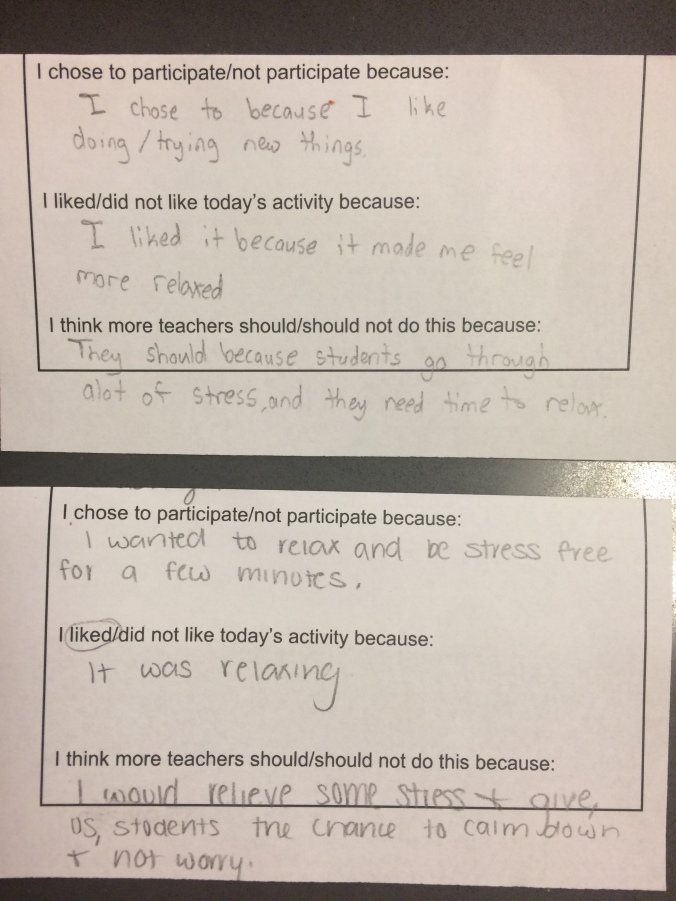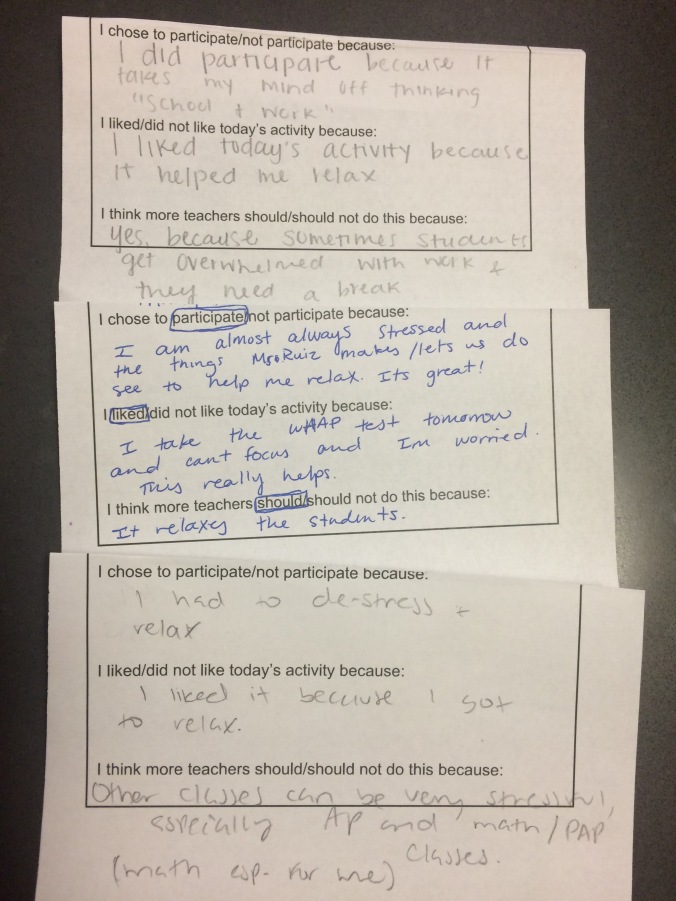My goodness this semester passed by in a blink of an eye! I have so many notes that say MUST BLOG ABOUT THIS, but a lack of posts to show for it.
In an effort to catch up on what’s been going on in my teacher world, I decided to begin with my journey into creating a more mindful classroom for both my students and for myself. I first experienced mindful practices at #SXSWEdu in March and I could not wait to get back to school to try out what I had learned.
Before we took our big state test in April, I tried an activity called 5-4-3-2-1. I started this practice by inviting students to sit quietly in their chairs, with their feet planted on the ground and their hands on their knees. I asked them if they were not going to participate to honor those that were by sitting quietly and to not distract others. I asked everyone to be mindful of the silence we were creating together, and that their voices were not needed for this activity but their minds were. First, I asked them to look for 5 colors within their field of vision. Then, they tried to notice 4 different sensations, whether it’s the coolness in the air from the AC, their body temperature, or maybe their hands tingling. For the third step, students listened for 3 different sounds. Then I asked them to take 2 deep breaths, and finally think of 1 positive thought that makes them feel good. At the end of this activity, I had students in every class tell me how calming yet energizing it was for them. One student said it was “the most relaxed he had felt in days.” I knew I was on to something.
After some research, I easily found a ton of online resources like CASEL and Mindful Schools. These sites provide not only different strategies teachers can use, but they also provide the brain research associated with practicing mindfulness. I’ve been teaching high school for a while now, but the unpredictability of teenagers never ceases to amaze me. I know reading more of the brain research will help me to better understand my students. Likewise, just from the few mindfulness activities we have tried, I believe students will better understand themselves. So far, my favorite practice is called a “body scan” that I took from this site.
After our daily reading time, I invited students to make the decision of whether or not they wanted to participate in another mindfulness activity. If they did not want to participate, I asked them to return to their seat and sit quietly. If they did want to join, I told them to find a space on the floor and sit down in a comfortable seated position, but to make sure there was enough room around them to lay down. I followed the steps suggested on the site but added my own words as well. I dimmed the lights and told students to slowly lay back in the space they chose. The body scan begins by focusing on your head and then moving your focus to your feet, so I instructed them to squeeze their eyes shut, scrunch their nose, make fists, and finally, to tighten their legs and toes. As they did this, I had students think of anything that was stressing them out: major grades due this week for my class or others. Upcoming AP tests. Babysitting. Having to work after school. I said to keep holding everything that bothered them in this tension, and then to take a deep breath and let it all go. I told them to actually let it go by relaxing their face and spreading their fingers as wide as possible. Then I invited them to either place their hands by their side or to place one hand on their heart and one on their stomach. I asked them to pay attention to their heartbeat and their breath, and to try to slow down each as we remained in silence. I used an ocean-sounds playlist I found on Spotify to allow them about a minute and a half to concentrate on what they were feeling. After a couple of minutes, I told them to wiggle their fingers and turn on their side in order to add energy back to their bodies. Then I asked them to sit up slowly and take one more final breath, while thinking of something positive to focus on.

Above: Taken at the end of the “body scan”. Some students are still focusing on their breath.
After the activity, I asked students to give me feedback in order to show my administrators since I plan to incorporate more mindful strategies next year. But honestly, I didn’t need written feedback. They were very vocal about how much they enjoyed it and I could feel the difference in the room. Everything felt much more relaxed and my students told each other how much more ready they felt to do the work we had to do.

Student feedback
This summer I plan to take a course in Social-Emotional Learning and Character Development offered by the Academy for Social-Emotional Learning in Schools. I am so excited to know more about how to help my students navigate the daily stress and anxiety they experience on top of the assignments I give them. In order to better serve my students, I must understand how to help them understand what it is they’re feeling so they can find ways to manage the stress of being a teenager. I’m currently reading a young adult novel called He Forgot to Say Goodbye by Benjamin Alire Saenz and a line by one of the main characters validated having a mindful classroom:
“You are the adults. I’m the kid. And yet it’s my job to understand you. But it’s not your job to understand me.”
